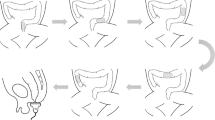Abstract
Fecal incontinence is a serious problem that may lead to social segregation and psychological problems. Patients with anorectal malformations frequently suffer from fecal incontinence even with an excellent anatomic repair. In these patients, an effective management program with enemas can improve their quality of life. We want to present our experience with hydrocolonic sonography as a diagnostic tool to predict the type and volume of enema needed to initiate an effective bowel management. Patients who presented with soiling regardless of the type of anomaly were included in the study. Thirty patients aged 4–18 were evaluated. The diagnostic program comprised a careful clinical history, physical examination, exact classification of the malformation, evaluation for associated defects, and stool protocol. Twenty patients suffered from true fecal incontinence and were included in a bowel management program. These patients received oral polyethyleneglycol to evacuate stool impaction. Bowel management was initiated with the help of hydrosonography to evaluate bowel motility. The volume of the enema was determined according to the amount of fluid that was needed to fill the colon to the cecum. Twenty patients were investigated with the help of hydrocolonic sonography. Eighteen patients were free of symptoms of soiling after 3 days of hospital treatment and remained free of symptoms 6 months and 1 year later at reevaluation. Two patients did not follow the therapeutic regime and, therefore, did not show an improved condition concerning soiling in the long run. Hydrocolonic sonography is a helpful diagnostic tool to assess colonic volume and motility to predict the type and volume of enema needed for an effective bowel management.




Similar content being viewed by others
References
Pena A (1995) Anorectal malformations. Semin Pediatr Surg 4(1):35–47
Holschneider A, Hutson J, Pena A, Bekhit E, Georgeson K, Iwai N et al (2005) Preliminary report on the international conference for the development of standards for the treatment of anorectal malformations. J Pediatr Surg 40:1521–1526
Pena A, Guardino K, Tovilla JM et al (1998) Bowel management for fecal incontinence in patients with anorectal malformations. J Pediatr Surg 33:133–137
Koltai JL, Pistor G (1985) Anorektale Inkontinenz. Urban and Schwarzenberg, Munich
Rubin C, Kurtz AB, Goldberg BB (1978) Water enema: a new ultrasound technique in defining pelvic anatomy. J Clin Ultrasound 6:28–33
Limberg B (2005) Diagnosis of inflammatory and neoplastic colonic disease by sonography. J Clin Gastroenterol 1987(9):607–611
Levitt M, Pena A (2005) Outcomes from the correction of anorectal malformations. Curr Opin Pediatr 17(3):394–401
Rintala R, Mildh L, Lindahl H (1992) Fecal continence and quality of life in adult patients with an operated low anorectal malformation. J Pediatr Surg 27(7):902–905
Rintala R, Mildh L, Lindahl H (1994) Fecal continence and quality of life in adult patients with an operated high or intermediate anorectal malformation. J Pediatr Surg 29(6):770–780
Holschneider A (1983) Treatment and functional results of anorectal continence in children with imperforate anus. Acta Chir Belg 82(3):191–204
Holschneider A (1990) Diagnosis and primary surgical therapy of anorectal abnormalities with regard to postoperative incontinence. Zentralbl Chir 115(22):1409–1422
Holschneider A, Koebke J, Meier-Ruge W, Land N, Jesch NK (2001) Pathophysiology of chronic constipation in anorectal malformations. Eur J Pediatr Surg 11:305–310
Pena A, Levitt MA (2002) Colonic inertia disorders. Curr Probl Surg 39:666–730
van Kuyk EM, Wissink-Essink M, Brugman-Boezeman AT, Oerlemans HM, Nijhuis-van der Sanden MW, Severijnen RS et al (2001) Multidisciplinary behavioral treatment of defecation problems: a controlled study in children with anorectal malformations. J Pediatr Surg 36:1350–1356
Schmiedecke E, Busch M, Stamatopoulos E, Lorenz C (2008) Multidisciplinary behavioural treatment of fecal incontinence and constipation after correction of anorectal malformation. World J Pediatr 4(3):206–210
Acknowledgments
The authors are members of the “Network for Systematic Investigation of the Molecular Causes, Clinical Implications and Psychosocial Outcome of Congenital Uro-Rectal Malformations (CURE-Net)” supported by a research grant (01GM08107) from the German Federal Ministry of Education and Research (Bundesministerium für Bildung und Forschung, BMBF).
Conflict of interest
The authors declare that they have no conflict of interest.
Author information
Authors and Affiliations
Corresponding author
Rights and permissions
About this article
Cite this article
Märzheuser, S., Schmidt, D., David, S. et al. Hydrocolonic sonography: a helpful diagnostic tool to implement effective bowel management. Pediatr Surg Int 26, 1121–1124 (2010). https://doi.org/10.1007/s00383-010-2687-1
Published:
Issue Date:
DOI: https://doi.org/10.1007/s00383-010-2687-1




